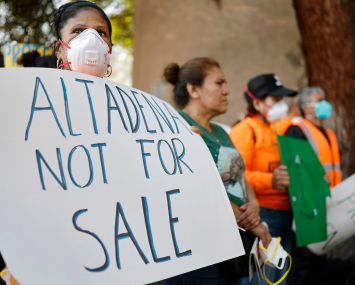Europe vs. America on ESG: Why One Might Overtake the Other
Oddly enough, it’s the more fractious U.S. that can play a solid long game on sustainability
By Anna Staropoli May 3, 2023 10:35 am
reprints
Roughly 50 years after America first put a man on the moon, the European Union declared an equivalent milestone.
“[The European Green Deal] is Europe’s man-on-the-moon moment,” announced European Commission President Ursula von der Leyen in 2019.
To really understand the gravity of this climate commitment, try to imagine that same legislative weight, publicly and collectively applied across the United States. Given America’s political polarization, legislative back and forth and, oh yeah, the barrage of anti-ESG discourse, it’s not so easy to envision, is it?
America clearly trails Europe in efforts related to environmental, social and corporate governance, especially the environmental part, though the gap between the two may not be as significant as the Atlantic Ocean. Real estate experts resoundingly agreed that American ESG is on track to not only catch up with the efforts of European real estate but to overtake them — all within the next few years, or the decade at the outside.
To get to that point, however, the United States has some work to do. Europe’s ESG measures — namely unified legislation, cultural emphasis and resilient building — have galloped ahead while America’s have bucked in fits and starts. Europe has set the bar for ESG, covering its bases both ethically and practically. As climate change continues to jeopardize the environment, America’s lag is all the more imminent to counteract.
Legislation has been the biggest driver of European ESG, said David-Alexandre Dahan, industry initiatives director of CREFC Europe, a trade group for CRE finance. Such legislation is multifaceted; it comes from both the E.U.’s overarching regulatory framework — that European Green Deal — as well as from major institutional investors who push the sustainability agenda.
In Europe, the Green Deal put climate efforts front and center across the European Union. Within that context, the E.U.’s Sustainable Finance Disclosure Regulation (SFDR) helped define sustainability from a financial and commercial point of view, said Jens Böhnlein, global head of asset management and sustainability at Commerz.
The SFDR regulations are part of a regulatory framework, along with the Corporate Sustainability Reporting Directive (CSRD) that outlines the E.U.’s ESG disclosure and standards. Energy Performance Certificates (EPCS) likewise help compare assets.
These guidelines serve the entire European Union and provide ESG directives to individual countries. This legislative framework ultimately transfers into local laws, so Germany (where Commerz is based) is then free to interpret the rules in a different manner than, say, Spain or France, said Böhnlein.
The United States has introduced some climate legislation but doesn’t have a comparable uniform reporting framework to the E.U.’s Green Deal. In 2022, the Senate approved the $369 billion Inflation Reduction Act, which has been lauded as the United States’ most significant climate law to date, even though the bill compromises the climate agenda with provisions for new oil and gas production.
“It’s quite telling, I think, that unlike regulation that has been put out by the European Parliament, U.S. Congress still hasn’t done any bill on climate,” said Dahan. “So, everything has come through more from the regulators rather than the legislators. Whereas, I think here in Europe, it’s been a combination; it’s been the legislators as well as the regulators.”
The United States is working on it, said Brittany Ryan, director of responsible investing at Nuveen.
The climate rules proposed by the U.S. Securities and Exchange Commission (SEC) are a step closer to the E.U.’s growth, said Ryan, as are President Joe Biden’s greenhouse gas emissions targets and the climate agenda outlined in the Paris Agreement,
However, America lacks a unified, comprehensive and cohesive climate policy right at the federal level.
“So you have some of that very soft commitment and soft expression of ESG forwardness,” said Ryan. “But in terms of having real meat to that, and on the regulatory side, that is just such a huge gap.”
The absence of federal legislation has hindered momentum in ESG, but tracks with America’s larger cultural posture on the matter. Specifically, the polarization of ESG in American politics and the individualistic nature of American businesses have converged to create an ESG climate that is distinctively American — and distinctively difficult by European standards.
The politicization of ESG particularly highlights the differences between America and Europe. The E.U. is a combination of 27 countries compared to the United States’ single federation. Yet the backlash to American ESG has contributed to a charged country that often feels like a collection of heterogeneous, battling nations.
In 2022, Texas, for example, banned funds that invested in ESG policies. More recently, in February 2023, Florida announced legislation to protect against ESG “wokeness.” “I’m happy when the regulators and the state don’t intervene,” said Dahan, “but when they intervene in the wrong way, it seems a bit strange. … There seems to be this clash of cultures in the U.S.”
While the anti-ESG movement has little scientific or financial credibility, the politicians roping ESG into the culture wars have nonetheless hamstrung climate efforts.
“It’s unfortunate to see that stymie progress,” said Ryan. “We really need to be cautious as a society and be educated as a society of what is it that we’re talking about.”
Unfortunately, changing the opinions of many Americans isn’t the only cultural conundrum at play. As a hyper-individualistic nation, Americans can struggle to act on situations that affect the collective if they’re not directly impacted, said Ryan.
“It’s very hard as a people, as a culture, to get on board with something that is seen as helping others and not ourselves,” she said. “And we really need to see a strong link between what we are requiring ourselves to do and how that actually supports and enhances our own livelihoods.”
While Europe likewise includes Western nations with individualist tendencies, it has traditionally leaned more socially democratic, with a stronger social safety net than the United States, said Ryan.
More simply, the E.U. has generally embraced ESG measures for one reason: “[It] wasn’t commercial,” said Böhnlein “It was basically to save the world.”
Compared to Europe, America is particularly business-oriented, he added. All throughout the ESG discourse, companies have reiterated that ESG is a smart financial decision. So, where there’s money, there’s opportunity. More financial incentives, like tax reductions for ESG-related initiatives, will likely see an acceleration in sustainable real estate.
Urgency will likewise spur the United States’ climate endeavors. Europe has seen its fair share of natural disasters, from wildfires to heat waves, which helped propel the E.U. to take action, said Ryan.
The U.S. has seen similar natural disasters, and these underline the need for quick, efficient ESG measures in accordance with the E.U.’s precedent. The more climate-related disasters that arise, the quicker the pace of change in the U.S., predicted Ryan. As the climate crisis hits home even more than it already has, with local jurisdictions buying out uninsurable towns or the seemingly endless list of significant natural disasters, more people will recognize the realities of climate change.
At that point, Americans will have no choice but to get on board with addressing both the impacts and causes of climate change. Everything that needs to happen with carbon capture, lithium ion battery recycling and the renewables industry will happen once the need becomes dire, said Ryan.
The trajectory of climate change bodes well for the future of American ESG, but less so for the future of the world and its 8 billion-plus inhabitants. “You know the analogy of the frogs in hot water?” asked Dahan. “And the frogs stay because it’s comfortable, it’s warm, etc., but then it boils and it’s too late to get out? It’s exactly the same, I think, for human beings, frankly, with climate change.”
However sobering that sentiment may be, urgency is an undeniable catalyst for action. American real estate will likely make environmental strides at an exponential rate, said Ryan; every year will see more progress than the one prior.
As for right now, America’s culture seemingly works against ESG, though not all components of American individualism have to be to the environment’s detriment.
Another opportunity for the U.S. to close the gap between Europe? Local and state laws, which perhaps foreshadow the potential of America’s progress. Local and state jurisdictions — for example, New York’s Local Law 97 and D.C.’s Building Energy Performance Standards (BEPS) — have lit a fire in individual cities.
No one region can escape climate risk, said Ryan, so individual states and regions have taken the impetus on themselves to respond accordingly.
Specifically, America’s local laws have set benchmarking rules that require utilities to share whole-building data, which has proven a weak spot in Europe. Europe is particularly struggling to access tenant data, said Ryan, which remains one gaping area across CRE.
Yes, even Europe — which often seems to operate as a unified collective from the America perspective — has its struggles. “Believe me, in Europe you see the differences,” said Dahan. “You still have all the arguments that you would have in one happy family.”
This remark emphasizes the fragmented nature of ESG in the E.U. While hyper-local legislation in America distinguishes individual cities and states, European local governance can make the difference between entire countries, collectively governed by the Green Deal.
On the one hand, different opinions make it more challenging to reach a united front to combat climate change. But on the plus side, open discussion leaves space for flexibility and allows individual E.U. nations opportunities to operate according to their individual characteristics, locations and necessities.
The Nordic countries, for example, tend to be at the forefront of ESG , said Dahan.
Walk the streets of Copenhagen, and you can see ESG built into Danish capital’s resilience. Copenhagen has essentially “designed for disaster,” Hyon Rah, former director of ESG consultancy at Savills, told Commercial Observer in April.
In this design, Copenhagen has identified potential areas of flooding that, in dry weather, can be used for recreational and communal purposes. When it rains, however, these places collect and drain the stormwater runoff, resulting in a smart and well-planned resilience strategy.
American cities can, and have, learned from European examples. In the wake of 2005’s Hurricane Katrina, New Orleans implemented a series of “Dutch Dialogues” workshops. These sessions embraced the Dutch principles of both living with and adapting to flood risks and utilizing water for its economic and recreational benefits, per the Louisiana State Presbytere Museum.
Efforts to prepare for natural disasters emphasize the dual nature of ESG-driven regulation, which demands both adaptation and prevention. This is especially pertinent in cities, which need to focus on both resilience for baked-in change, and decarbonization and other preemptive measures, to ward off further disaster.
The ability to adapt may ultimately be a propelling force in American ESG as cities wake up to the need for adaptation. Boston, for example, has instituted a climate resilience checklist, said Ryan, and has begun to think more broadly about its resilience strategy. The city’s Climate Ready Boston initiatives come with maps and resources that promote greater transparency.
Globally, cities have stepped up to the plate. Yet independent of Europe or America, building for resilience — and building for the future — is an area to improve upon across ESG strategies, said Böhnlein.
Another area in which the U.S. can capitalize? Carbon investments.
In particular, wind and solar power present a viable opportunity for America to make up lost ground. U.S. renewable energy has nearly quadrupled over the last decade, while the cost of solar power has dropped by roughly 80 percent. Remember that America is a business-driven country, and the sinking costs of renewable energy bode positively for ESG’s future.
Likewise, America has more free land available than Europe, said Böhnlein. The amount of empty, wild space in America enables a more widespread implementation of wind and solar power as the years progress. (Heck, anti-ESG Texas produces more wind power than any other state.) European countries don’t have this same space, nor do they have the same level of technology.
Herein lies one of the most significant opportunities for America to catch up with Europe. Proptech isn’t exactly a new tool, but it’s one that can move American ESG from trailing to trailblazing.
“Much of what advances ESG agendas, sustainability goals, decarbonization goals is actually really reliant on technology advancements,” said Ryan. “That is kind of where the U.S. seems to prevail. It’s all about innovation and market leadership.”
Combating climate change requires research, development and speed, as well as the ability to scale up, said Dahan. These are typical characteristics of the U.S. market.
Europe, however, as a collection of different markets, faces challenges in scaling ESG endeavors across the E.U. The fragmented nature of Europe is a downside to technological innovation and scale.
So, the unilateral structure of the United States — it’s just one country, despite its political polarization — may very well be the characteristic that propels ESG’s progress.
Even without the regulatory framework, America’s ability to scale and innovate with ESG measures may be enough to build traction over the next decade. Dahan believes that the U.S. will not only catch up with Europe but also, eventually, overtake the E.U. entirely in ESG endeavors.
Ryan, however, isn’t so sure.
“I don’t know if we could ever say that we’ll be ahead of Europe,” she said, “because I think there really [are] just such serious culture differences that keep us separate.”
Regardless of culture and country, the world doesn’t have the luxury of time. ESG momentum in American real estate hinges on a slew of unpredictable but imminent variables, rather than known entities. The increasingly chaotic onset of natural disasters, the fluctuating state of politics and the ever-evolving nature of technology will all contribute to America’s progress.
The frogs in the simmering pot are starting to worry, said Dahan, so this progress will likely happen quickly.
America is slated to pull up to — and perhaps pass — Europe within the next few years. Next year, however, and its presidential race, may bring that timeline into a sharper focus. “Can we ask that question after the ’24 election?” said Dahan.
Anna Staropoli can be reached at astaropoli@commercialobserver.com.


